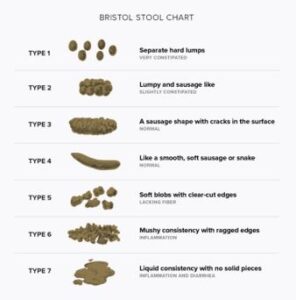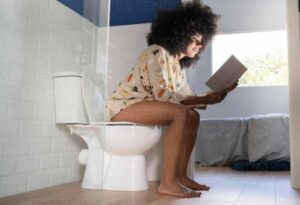Your poop’s shape, texture, and consistency can provide a significant insight into your digestive health. According to the Bristol Stool Chart, human fecal discharge is categorized into seven types of which only two are considered healthy and most typical for a well-functioning digestive system.
We examined poop color in one of our previous episodes and noted that brown and or any shade of brown is ideal. Any distinctive non-brown colored stool is a red flag. ICYMI visit: https://www.citizencomfort.com/2024/06/15/is-your-poop-color-correct/
Gastroenterologists affirm that your poop (stool) is an important clue to your overall digestion and health: Your poop, according to the experts, can reveal serious signs of infections, digestive problems, and even early signs of cancer.
Fecal matter is not a one-dimensional product. It can be big or small. It can be round or oblong. It can be hard, soft, or even liquid in form. Poops’ various forms, according to Bristol Chart, have corresponding health concerns
Bristol Stools Chart
Type 1: Separate hard lumps, like little pebbles.
Type 2: Sausage-shaped but lumpy.
Type 3: Like a sausage but with cracks on the surface.
Type 4: Like a smooth, soft sausage or snake.
Type 5: Soft blobs with clear-cut edges.
Type 6: Fluffy pieces with ragged edges, a mushy stool.
Type 7: Watery, no solid pieces.
The categorization was devised by doctors in the Bristol Royal Infirmary, England, and based on the bowel movements of nearly 2,000 people.

Poop Type & Digestive Health
Gastroenterologists say that type 3 or type 4 is the healthiest poop type that expels easily. It’s reflective of a healthier diet, particularly fiber-rich diets, and lifestyle, says Dr. Lee of Cleveland clinic. Dr Mehmet Oz said that fiber-rich foods ensure a perfect poop that is log-like and S-shaped, not broken up into pieces. This is because fibers keep the poop bulk and stuck together as they exit the body.
The other five types, experts say, may be signaling that something is wrong internally.
Type 1 and Type 2 poops signal constipation and can be difficult or painful to expel. The most common cause is not enough fluids. “It’s often a sign you should be drinking more,” explains Dr. Lee. Adding fiber to your diet and exercise to your daily routine will also help move things along.
A Type 5 poop is a pointer to lack of fiber in your body. Fiber helps to soak up fluid and firm things up. If your fecal discharge is type 5 persistent, you may be running bowel issues risk.
Type 6 and Type 7 may mean diarrhea and could signal an illness, food poisoning or some other digestive or intestinal issue. See a doctor if your poop texture consistently registers on this part of the chart.
Thin Poops
Anish Sheth said pencil-thin poops can be a sign of rectal cancer, which narrows the opening through which stool passes. If you persistently expel thin poops, consult your doctor.
Poop Frequency
Many health care providers agree that normal poop can be three time a day to three time a week. Stooling more than three times is considered diarrhea while fewer than three times a week is constipation.
It’s toilet Not Library
No matter how beautiful or inviting the toilet setup can be, it’s not a place of rest or a place to read newspapers or get busy with smart phone. Staying too long in the toilets has negative consequences. Studies suggest that the more time you spend in the bathroom, specifically reading, the more likely you are to develop hemorrhoids, or swollen blood vessels in and around the anus. Sitting for too long on the toilet can restrict blood flow around the anal area, which can make hemorrhoids worse.

Bacteria can travel with you from the toilet particularly when you fail to observe proper hygiene after each visit to the toilet. A study in 2011 by British researchers discovered contamination of one in six cell phones by E.coli bacteria after examining 400 cellphones from 12 different cities. These cellphones were not taken directly to the toilet but got contaminated because the users didn’t wash their hands after visiting the toilet. So, just imagine the level of bacteria that can get trapped in the cellphones when you browse with them right there in the toilet.
Source: Dare Agbeluyi, Chief Publisher.
Publisher’s Note:
- Leave your comments in the comments box below and share the post
- Send your health- related articles, stories, tips to compack2006@yahoo.co.ukfor free publication
- Like and share our Facebook page: @citizencomfortng
- Follow us on Instagram: citizencomfort01_ng


